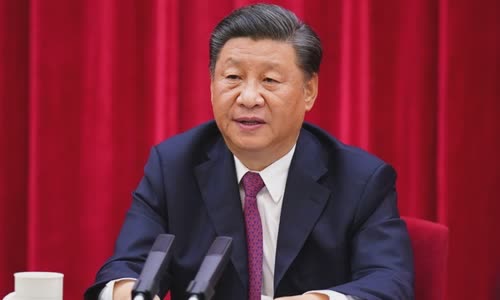Faced with "the outside environment with many headwinds" in the midst of the pandemic, China must help itself to overcome it, President Xi Jinping emphasized.
Mr. Xi recently visited corn fields at the "Yellow Corn Belt" in Jilin Province, amid worries about growing food supplies following the complicated developments of Covid-19.

President Xi Jinping speaks at an event commemorating China's victory over Japan in World War II on September 4 Photo: AFP.
Through such trips, President Xi Jinping wants to convey an important message: China needs to restructure its economy to become more self-reliant in a turbulent post-Covid-19 world,
He once said that China needs people to spend more and that manufacturers must actively innovate to reduce their dependence on the volatile economy abroad.
"The world has entered a period of rapid turmoil and change," Xi told prominent Chinese economists at a conference in Beijing late last month.
President Xi calls his new initiative a "dual circulation" strategy.
To many, President Xi's latest initiative resembles another version of the economic reform promise that China's leadership has made since at least 2006: Helping domestic consumption play a larger role in operations.
However, President Xi's new strategy is taking very seriously.
"This policy has a lot to do with the changing international environment that China faces, especially the deterioration of US-China relations," said Yao Yang, dean of the National Development School, North University.
Chinese officials and experts have been rushing to offer suggestions to realize President Xi's strategy.
Xi has stated that "dual circulation" will shape China's next five-year development plan.
Chinese leaders will have to evaluate proposals to meet President Xi's goals as they work together to develop a five-year plan.
"I think China is preparing for a more segregated scenario," said Zhu Ning, vice president of the Shanghai Institute of Advanced Finance, in an interview.
The path President Xi is taking reflects a broader strategy he outlines for China in the context of the US and other Western powers still in chaos over the Covid-19 crisis, he said.
During a tour of the agricultural lands in northeastern China in July, he mentioned to make sure the country can support itself.
China is "facing an external environment where the global market is gradually shrinking," he said during his visit to Anhui.
Strengthening our economic reconstruction efforts is a "long-term strategic move," he stressed, as if to dispel any doubts about his resolve.
President Xi's program will likely provide more measures to support domestic services industries, such as tourism, and more support for new sources of energy to replace imported oil, said Wang Wen.
To increase domestic consumption, the Chinese government needs to significantly reduce social income inequality.
"At least theoretically, any attempt to reduce inequality will drive domestic consumption," said Jane Golley, an economist at the Australian National University in Canberra.
Xi's "dual circulation" initiative is likely to have immediate effects by doubling efforts to build domestic technology and reducing dependence on foreign-made microchips and other
Many Chinese officials and analysts say US hostility has forced Beijing to spend more heavily to create its own important technologies.
The new strategy does not mean that Beijing will close to foreign investors and markets, Chinese officials stressed.
A debate is erupting over what China should do to strengthen its economic fortification but still have wide access to foreign markets.
Professor Yu Yongding, an economist in Beijing, last month sparked controversy when arguing that Xi's new initiative should include efforts to improve the "Made in China 2025" program, a chapter
Mr. Xi often tends to set out a big goal first, then let his subordinates propose a strategy and method of implementation.
"The Chinese leaders do not put up such slogans because they think things will be easy. They put them up so that all levels of the apparatus must focus, be flexible and prioritize them",



 Fagbohun Kazeem Olawale
Fagbohun Kazeem Olawale







